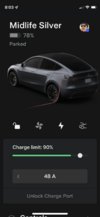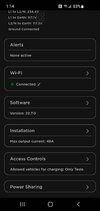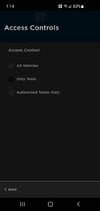So my Y recently started to not charge at home. It was giving me a solid blue light with the app displaying a red charging cable. I was also not able to charge at a hotel Tesla destination charger. I was able to charge at a supercharger. I did have it set for off peak charging but turned that off thinking that was the problem. It is still not charging. Any ideas??
Welcome to Tesla Motors Club
Discuss Tesla's Model S, Model 3, Model X, Model Y, Cybertruck, Roadster and More.
Register
Install the app
How to install the app on iOS
You can install our site as a web app on your iOS device by utilizing the Add to Home Screen feature in Safari. Please see this thread for more details on this.
Note: This feature may not be available in some browsers.
-
Want to remove ads? Register an account and login to see fewer ads, and become a Supporting Member to remove almost all ads.
You are using an out of date browser. It may not display this or other websites correctly.
You should upgrade or use an alternative browser.
You should upgrade or use an alternative browser.
Charges at supercharger but not at home or destination chargers
- Thread starter Midlife Silver
- Start date
Any ideas??
That you have a bad onboard charger in the car. Classic symptom of "can not charge with any level 2 charger but can supercharge". supercharging bypasses the onboard charger.
Make a service appointment (if you havent already) then drive to your local service center and see if they can squeeze you in. It appears to me that you joined TMC to ask this question, so thats the advice I would give you.
Yep, got a plenty good idea.
Fundamentally, sitting in front of the battery, is the actual charger. This is a DC-DC converter (DC in, DC out), whose output voltage and current into the battery is controlled and actually makes electrons flow into the battery.
Now, the input for the actual charger comes from one of two places:
Pretty clear, then: Your actual charger in the car, that DC->DC converter, is working just fine.
The AC->DC rectifier appears to be out to lunch.
Now that we know the general area.. that's cool, but neither you nor I are going to be able to fix this. There's lots that can go wrong: Loose wires, blown fuses, blown transistors, parts that should be soldered but aren't, parts that shouldn't be soldered together but are, diodes that aren't diodes any more, bad ICs, etc., etc.. (Can you tell I diagnose broken electronics for a living?)
At this point, fire up your app, select Service, Select Battery, Select Charging. Tell them the Evil That Has Befallen you. This is what warranties are for; my experience with Tesla is that they fix stuff like this pretty quickly.
One minor suggestion. I don't feel totally comfortable with the idea. You might try, with your mobile connector, hooking up to a 120 VAC wall socket, and see if the car will charge with that. But. You've got a failure in the car. This kind of stuff is electrical high power: For sure, it's not a table lamp. If Things Go Wrong, smoke and worse can happen. More likely, before smoke, you'll get a blown fuse, but it does mean additional hardware going that-a-way if something bad happens.
It's kind of like finding a gas leak on an ICE car. Yes, you can drive it around. Um. Do you really want to do that? In fact, if I were you, driving that car right now, until this gets fixed, might be something one might want to think twice about.
Fundamentally, sitting in front of the battery, is the actual charger. This is a DC-DC converter (DC in, DC out), whose output voltage and current into the battery is controlled and actually makes electrons flow into the battery.
Now, the input for the actual charger comes from one of two places:
- A DC voltage from a supercharger.
- A DC voltage from an AC rectifier.
Pretty clear, then: Your actual charger in the car, that DC->DC converter, is working just fine.
The AC->DC rectifier appears to be out to lunch.
Now that we know the general area.. that's cool, but neither you nor I are going to be able to fix this. There's lots that can go wrong: Loose wires, blown fuses, blown transistors, parts that should be soldered but aren't, parts that shouldn't be soldered together but are, diodes that aren't diodes any more, bad ICs, etc., etc.. (Can you tell I diagnose broken electronics for a living?)
At this point, fire up your app, select Service, Select Battery, Select Charging. Tell them the Evil That Has Befallen you. This is what warranties are for; my experience with Tesla is that they fix stuff like this pretty quickly.
One minor suggestion. I don't feel totally comfortable with the idea. You might try, with your mobile connector, hooking up to a 120 VAC wall socket, and see if the car will charge with that. But. You've got a failure in the car. This kind of stuff is electrical high power: For sure, it's not a table lamp. If Things Go Wrong, smoke and worse can happen. More likely, before smoke, you'll get a blown fuse, but it does mean additional hardware going that-a-way if something bad happens.
It's kind of like finding a gas leak on an ICE car. Yes, you can drive it around. Um. Do you really want to do that? In fact, if I were you, driving that car right now, until this gets fixed, might be something one might want to think twice about.
I recently had the same issue with my 2021 M3LR. The only difference was I would plug in and the light would go from blue to just off. Mobile charger didn't work, destination chargers didn't work, only Super Chargers and non-tesla DC charging worked. You need to get the Power ECU module replaced via a service appointment.
NOTE: It may take a while for them to get a replacement part for... reasons. It took me a couple weeks before they could replace. So request a loaner when you make the appointment, or be ready to super charge until the part is available and you can take it in for the swap.
The actual repair only takes them a few hours.
NOTE: It may take a while for them to get a replacement part for... reasons. It took me a couple weeks before they could replace. So request a loaner when you make the appointment, or be ready to super charge until the part is available and you can take it in for the swap.
The actual repair only takes them a few hours.
Sound like you diagnosed it! I did try a 120 outlet with the same results. I will set up an appointmentYep, got a plenty good idea.
Fundamentally, sitting in front of the battery, is the actual charger. This is a DC-DC converter (DC in, DC out), whose output voltage and current into the battery is controlled and actually makes electrons flow into the battery.
Now, the input for the actual charger comes from one of two places:
Let's talk about #2. City power at your house or at destination chargers comes in AC; level 1 is 120 VAC, Level 2 is 208/220 VAC. Either of these gets rectified, that is, converted to DC, and then gets sent to the car's charger.
- A DC voltage from a supercharger.
- A DC voltage from an AC rectifier.
Pretty clear, then: Your actual charger in the car, that DC->DC converter, is working just fine.
The AC->DC rectifier appears to be out to lunch.
Now that we know the general area.. that's cool, but neither you nor I are going to be able to fix this. There's lots that can go wrong: Loose wires, blown fuses, blown transistors, parts that should be soldered but aren't, parts that shouldn't be soldered together but are, diodes that aren't diodes any more, bad ICs, etc., etc.. (Can you tell I diagnose broken electronics for a living?)
At this point, fire up your app, select Service, Select Battery, Select Charging. Tell them the Evil That Has Befallen you. This is what warranties are for; my experience with Tesla is that they fix stuff like this pretty quickly.
One minor suggestion. I don't feel totally comfortable with the idea. You might try, with your mobile connector, hooking up to a 120 VAC wall socket, and see if the car will charge with that. But. You've got a failure in the car. This kind of stuff is electrical high power: For sure, it's not a table lamp. If Things Go Wrong, smoke and worse can happen. More likely, before smoke, you'll get a blown fuse, but it does mean additional hardware going that-a-way if something bad happens.
It's kind of like finding a gas leak on an ICE car. Yes, you can drive it around. Um. Do you really want to do that? In fact, if I were you, driving that car right now, until this gets fixed, might be something one might want to think twice about.
I had the same problem, figured out solution myself through trial and error.
1) go to WiFi settings on your phone, and connect to Tesla Wall Charger. (It will say "connected, without internet". This is fine.
2) go to Internet browser on your phone and type: 192.168.92.1
3) this will take you to your wall charger page. Scroll down to where it says "Access Controls". Hit that.
4) on next page, it will have three options.
*All Vehicles
*Only Tesla
*Authorized Tesla's Only
The authorized only was the default. So it will only charge the car that was originally set up for the charger at install.
5) switch to Only Tesla.
should be good to go from there, it was for me!

if that doesn't work, then probably something wrong with the charger if rebooting doesn't work.
I attached pics of my screenshots. Good luck!
1) go to WiFi settings on your phone, and connect to Tesla Wall Charger. (It will say "connected, without internet". This is fine.
2) go to Internet browser on your phone and type: 192.168.92.1
3) this will take you to your wall charger page. Scroll down to where it says "Access Controls". Hit that.
4) on next page, it will have three options.
*All Vehicles
*Only Tesla
*Authorized Tesla's Only
The authorized only was the default. So it will only charge the car that was originally set up for the charger at install.
5) switch to Only Tesla.
should be good to go from there, it was for me!
if that doesn't work, then probably something wrong with the charger if rebooting doesn't work.
I attached pics of my screenshots. Good luck!
Attachments
Similar threads
- Replies
- 6
- Views
- 404
- Replies
- 1
- Views
- 170
- Replies
- 5
- Views
- 260
- Replies
- 6
- Views
- 270
- Replies
- 3
- Views
- 351





